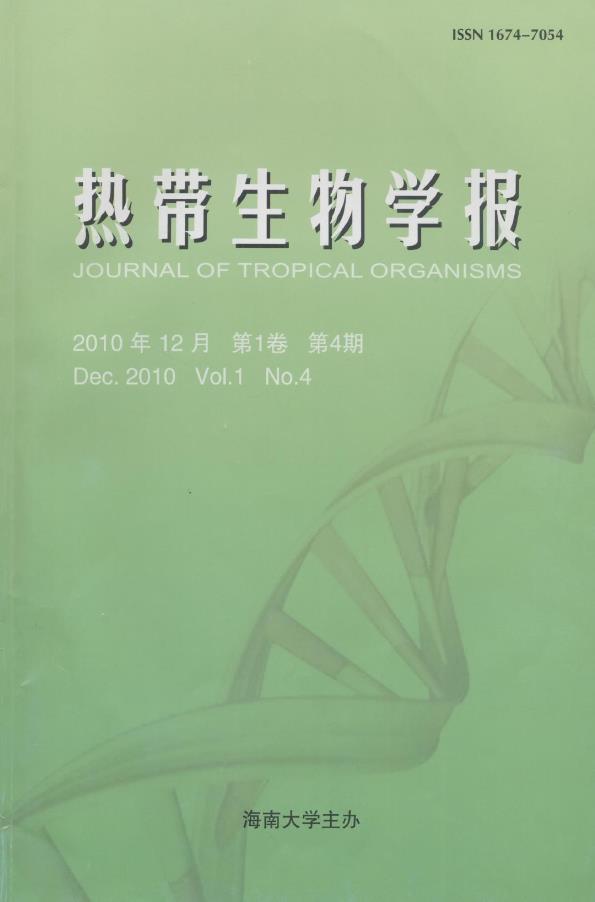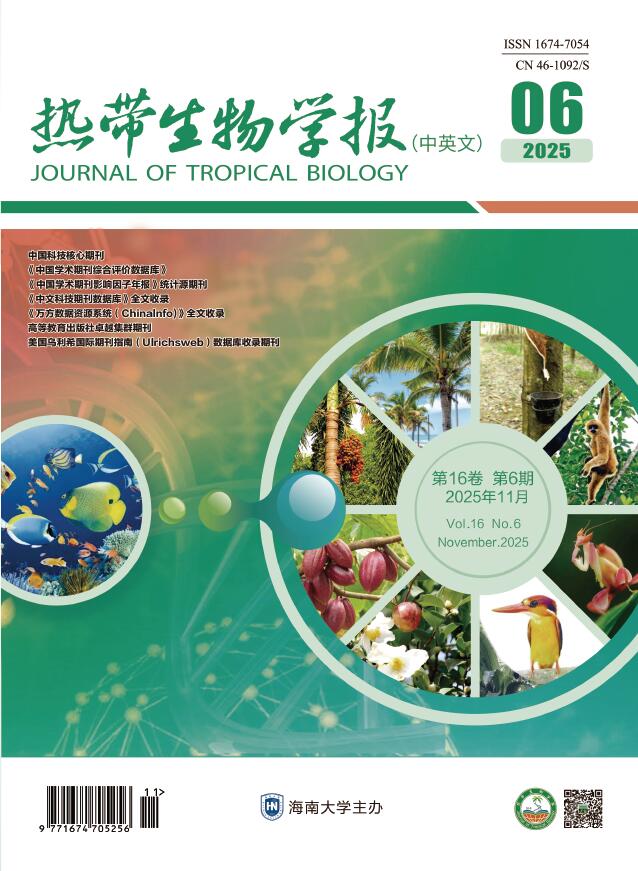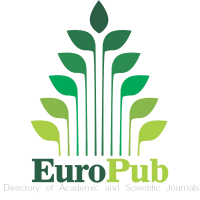2010 Vol. 1, No. 4
2010, 1(4): 293-300.
doi: 10.15886/j.cnki.rdswxb.2010.04.006
Abstract:
In the paper,the economic value of Ilex kudingcha C. J. Tseng was discussed and the necessity andurgency of its anthracnose resistant breeding toColletotrichum illics-kudingchaewere elucidated;the significanceof the Dual Molecular Marker,i. e.RAPD-SCAR and AFLP-SCAR,to the resistant breeding to Colletotrichumillics-kudingcha were introduced,and the research strategy for the key problems which must be solved so that theresistibility could be successesfully marked by SCAR were proposed and the feasibility were analyzed;the resultsof this project were anticipated and the creative significance of the application of the dual Molecular Mark,i. e. ,RAPD-SCAR and AFLP-SCAR,in the resistant breeding to Colletotrichum illics-kudingchae C. J. Tseng. were also discussed.
In the paper,the economic value of Ilex kudingcha C. J. Tseng was discussed and the necessity andurgency of its anthracnose resistant breeding toColletotrichum illics-kudingchaewere elucidated;the significanceof the Dual Molecular Marker,i. e.RAPD-SCAR and AFLP-SCAR,to the resistant breeding to Colletotrichumillics-kudingcha were introduced,and the research strategy for the key problems which must be solved so that theresistibility could be successesfully marked by SCAR were proposed and the feasibility were analyzed;the resultsof this project were anticipated and the creative significance of the application of the dual Molecular Mark,i. e. ,RAPD-SCAR and AFLP-SCAR,in the resistant breeding to Colletotrichum illics-kudingchae C. J. Tseng. were also discussed.
2010, 1(4): 301-306,313.
doi: 10.15886/j.cnki.rdswxb.2010.04.009
Abstract:
The improved CTAB method was used to extract genomic DNA of Daucus carota L. var. sativa.,which were used as the template for ISSR-PCR. A optimal ISSR-PCR reaction system suitable to Daucus carota L. var. sativa DC. was established via single factor experiments. The optimal ISSR-PCR system was that 25 μL reaction solution contained 2.5 μL 10×PCR buffer,2.5—3.0 mmol·L-1 Mg2+,200μmol·L-1 dNTPs,1.5U Taq polymerase,0.5 μmol·L-1 primers,20ng DNA template.The optimized amplification program was that pre-denaturing at 94 ℃ for 4min,then denaturing at 94 ℃ for 40 s,primer annealing at 48 ℃—58 ℃ for 45 s,extension at 72 ℃ for 2 min,for 35 cycles,extension at 72 ℃ for 8min. The products were stored at 16 ℃. 24 effective primers were screened out.
The improved CTAB method was used to extract genomic DNA of Daucus carota L. var. sativa.,which were used as the template for ISSR-PCR. A optimal ISSR-PCR reaction system suitable to Daucus carota L. var. sativa DC. was established via single factor experiments. The optimal ISSR-PCR system was that 25 μL reaction solution contained 2.5 μL 10×PCR buffer,2.5—3.0 mmol·L-1 Mg2+,200μmol·L-1 dNTPs,1.5U Taq polymerase,0.5 μmol·L-1 primers,20ng DNA template.The optimized amplification program was that pre-denaturing at 94 ℃ for 4min,then denaturing at 94 ℃ for 40 s,primer annealing at 48 ℃—58 ℃ for 45 s,extension at 72 ℃ for 2 min,for 35 cycles,extension at 72 ℃ for 8min. The products were stored at 16 ℃. 24 effective primers were screened out.
2010, 1(4): 307-313.
doi: 10.15886/j.cnki.rdswxb.2010.04.014
Abstract:
The nucellar tissue from the young seeds of rubber tree clone Reyan 88-13 was used to induce embryogenic callus. The different culture parameters such as the different types and concentrations of plant growth regulators and different calcium concentrations in embryogenic callus induction media and subculture media had been analyzed and the optimal culture parameters had been determined. Through continuous subculture and selection for 5 months,friable embryogenic callus had been gradually obtained. Long term subculture had been carried on for the friable embryogenic calli. Histological sections proved that the calli proliferated by long term subculture maintained the embryogenic characters. The nucellar friable and embryogenic calli of rubber tree clone Reyan 88-13 that had been subcultured for more than 2 years were used for inducing embryoids,and 186 embryoids were obtained,which were being used to induce plant regeneration.
The nucellar tissue from the young seeds of rubber tree clone Reyan 88-13 was used to induce embryogenic callus. The different culture parameters such as the different types and concentrations of plant growth regulators and different calcium concentrations in embryogenic callus induction media and subculture media had been analyzed and the optimal culture parameters had been determined. Through continuous subculture and selection for 5 months,friable embryogenic callus had been gradually obtained. Long term subculture had been carried on for the friable embryogenic calli. Histological sections proved that the calli proliferated by long term subculture maintained the embryogenic characters. The nucellar friable and embryogenic calli of rubber tree clone Reyan 88-13 that had been subcultured for more than 2 years were used for inducing embryoids,and 186 embryoids were obtained,which were being used to induce plant regeneration.
2010, 1(4): 314-320.
doi: 10.15886/j.cnki.rdswxb.2010.04.015
Abstract:
In order to screen the interacting proteins of sucrose transporters (SUTs) from Hevea brasiliensis,the bait vectors of the six sucrose transporters of cytoplasmic yeast two-hybrid system,which was based on Sos recruitment system (SRS),were constructed and detected for their self activity. The coding sequences of SUTs were obtained by PCR from the plasmids containing respective Hevea SUTs,and the amplified products were cloned into the bait vector pSos at site Sal Ⅰ and Not Ⅰ. Restriction analysis and sequencing confirmed the sequence identity and the correct in frame fusion with the Sos gene of pSos. The resultant bait vectors of the 6 HbSUT genes were termed as pSos-SUTs. The pSos-SUTs were transformed into the temperature-sensitive strain cdc25H,and detected for their self activating effects. The results showed that except for pSos-SUT5,the other five bait vectors had no autonomous activation upon the yeast strain,which were suitable for the follow-up studies.
In order to screen the interacting proteins of sucrose transporters (SUTs) from Hevea brasiliensis,the bait vectors of the six sucrose transporters of cytoplasmic yeast two-hybrid system,which was based on Sos recruitment system (SRS),were constructed and detected for their self activity. The coding sequences of SUTs were obtained by PCR from the plasmids containing respective Hevea SUTs,and the amplified products were cloned into the bait vector pSos at site Sal Ⅰ and Not Ⅰ. Restriction analysis and sequencing confirmed the sequence identity and the correct in frame fusion with the Sos gene of pSos. The resultant bait vectors of the 6 HbSUT genes were termed as pSos-SUTs. The pSos-SUTs were transformed into the temperature-sensitive strain cdc25H,and detected for their self activating effects. The results showed that except for pSos-SUT5,the other five bait vectors had no autonomous activation upon the yeast strain,which were suitable for the follow-up studies.
2010, 1(4): 321-326.
doi: 10.15886/j.cnki.rdswxb.2010.04.001
Abstract:
In order to explore the phylogenetic relationships of gymnothorax species in South China Sea,504 bp length fragments of mitochondrial cytochrome oxidase subunit Ⅰ gene from 6 species of genus Gymnothorax (G. flavimarginatus,G.reticularis,G.melanospilus,G.rueppeliae,G.fimbriatus,G. favagineus) in South China Sea were sequenced. Based on the phylogenetic analysis of the homologous sequences of COⅠ gene sequences of Gymnothorax from 3 species in South China Sea and 1 species in Japan downloaded from GenBank,neighbor-joining (NJ ) and maximum parsimony (MP) methods were used to construct molecular phylogenetic trees. The results indicated that there were 187 nucleotide sites substituted(37.1%) in 504 bp sites;the average value of transition/transversion ratios was 1.5;nucleotide sequence divergence was only 0.20 % between G.fimbriatus and G. favagineus,which supported the opinion that G.fimbriatus and G. favagineus might be synonyms; the NJ tree and the MP tree Clustering maps showed that the genetic differentiation of G.reticularis and G.kidako was in the same branch,and the genetic differentiation of eight species Gymnothoraxas in another branch.
In order to explore the phylogenetic relationships of gymnothorax species in South China Sea,504 bp length fragments of mitochondrial cytochrome oxidase subunit Ⅰ gene from 6 species of genus Gymnothorax (G. flavimarginatus,G.reticularis,G.melanospilus,G.rueppeliae,G.fimbriatus,G. favagineus) in South China Sea were sequenced. Based on the phylogenetic analysis of the homologous sequences of COⅠ gene sequences of Gymnothorax from 3 species in South China Sea and 1 species in Japan downloaded from GenBank,neighbor-joining (NJ ) and maximum parsimony (MP) methods were used to construct molecular phylogenetic trees. The results indicated that there were 187 nucleotide sites substituted(37.1%) in 504 bp sites;the average value of transition/transversion ratios was 1.5;nucleotide sequence divergence was only 0.20 % between G.fimbriatus and G. favagineus,which supported the opinion that G.fimbriatus and G. favagineus might be synonyms; the NJ tree and the MP tree Clustering maps showed that the genetic differentiation of G.reticularis and G.kidako was in the same branch,and the genetic differentiation of eight species Gymnothoraxas in another branch.
2010, 1(4): 327-330.
doi: 10.15886/j.cnki.rdswxb.2010.04.017
Abstract:
An in vivo method was used to determine the Nitrate reductase (NR) activity in the different tissue from Enhalus acoroides in the Xincun Bay of Hainan Island. The effects of pH of the assay media(7,8 and 9),temperature (5 ℃ steps,from 20 to 40 ℃) and KNO3 concentrations(50 mmol·L-1 steps,from 50 to 250 mmol·L-1)on leaf NR activity were tested. The results indicated that both assay temperature and KNO3 concentration had a significant effect on NR activity,but pH not; the optimal assay medium contained 100 mmol·L-1 KNO3,0.5 mmol·L-1 Na-EDTA,phosphate buffer (pH=8.0),10 mmol·L-1 glucose,0.5%(v:v) 1-propanol,and at 30 ℃. NR activity in leaves was 1.01 μmol·g-1·h-1,0.08 μmol·g-1·h-1 in roots and 0.001 μmol·g-1·h-1 in shoots under the optimal assay medium conditions.
An in vivo method was used to determine the Nitrate reductase (NR) activity in the different tissue from Enhalus acoroides in the Xincun Bay of Hainan Island. The effects of pH of the assay media(7,8 and 9),temperature (5 ℃ steps,from 20 to 40 ℃) and KNO3 concentrations(50 mmol·L-1 steps,from 50 to 250 mmol·L-1)on leaf NR activity were tested. The results indicated that both assay temperature and KNO3 concentration had a significant effect on NR activity,but pH not; the optimal assay medium contained 100 mmol·L-1 KNO3,0.5 mmol·L-1 Na-EDTA,phosphate buffer (pH=8.0),10 mmol·L-1 glucose,0.5%(v:v) 1-propanol,and at 30 ℃. NR activity in leaves was 1.01 μmol·g-1·h-1,0.08 μmol·g-1·h-1 in roots and 0.001 μmol·g-1·h-1 in shoots under the optimal assay medium conditions.
2010, 1(4): 331-336.
doi: 10.15886/j.cnki.rdswxb.2010.04.002
Abstract:
Diversity of 20 Conus species native to Hainan,each of which involved 27 traits,were investigated with software NTSYS-pc 2.10e based on numerical taxonomy methods including Q cluster analysis,R cluster analysis and principal components analysis ( PCA ). The results showed that 20 cone snails could be classified into 2 groups and 3 subgroups with Q cluster analysis,and 27 traits could be classified into 2 groups with R cluster analysis; Principal components analysis ( PCA ) indicated that the shell size,inner lip and mouth characteristics etc. were of significance for Conus taxonomy; the 3 dimensions plot of the first 3 principal components analysis of 20 Conus species was consistent with that of cluster analysis; the relationship for the 20 species have been analyzed by Q cluster dendrogram,and the combination of R cluster and principal components analysis was helpful for selecting the key characters for genus Conus classification.
Diversity of 20 Conus species native to Hainan,each of which involved 27 traits,were investigated with software NTSYS-pc 2.10e based on numerical taxonomy methods including Q cluster analysis,R cluster analysis and principal components analysis ( PCA ). The results showed that 20 cone snails could be classified into 2 groups and 3 subgroups with Q cluster analysis,and 27 traits could be classified into 2 groups with R cluster analysis; Principal components analysis ( PCA ) indicated that the shell size,inner lip and mouth characteristics etc. were of significance for Conus taxonomy; the 3 dimensions plot of the first 3 principal components analysis of 20 Conus species was consistent with that of cluster analysis; the relationship for the 20 species have been analyzed by Q cluster dendrogram,and the combination of R cluster and principal components analysis was helpful for selecting the key characters for genus Conus classification.
2010, 1(4): 337-341.
doi: 10.15886/j.cnki.rdswxb.2010.04.010
Abstract:
Fusarium wilt of banana is a destructive fungus disease caused by Fusarium oxysporum f.sp.Cubense,and which is serious harm to banana planting and its industry development. In order to study the pathogenic mechanism of the disease and the resistance mechanism of banana,tissue isolation method was used to isolate and purify the candidate fungus strain,which were observed by morphological method; CTAB method was used to extract DNA of fungus,and ITS (Internal Transcribed Spacers) sequence was amplified and analyzed; the pathogenic fungus were identified by molecular method. The results indicated that the candidate strain was Fusarium oxysporum f.sp.Cubense.,and which was confirmed as pathogenic fungi of banana wilt disease.
Fusarium wilt of banana is a destructive fungus disease caused by Fusarium oxysporum f.sp.Cubense,and which is serious harm to banana planting and its industry development. In order to study the pathogenic mechanism of the disease and the resistance mechanism of banana,tissue isolation method was used to isolate and purify the candidate fungus strain,which were observed by morphological method; CTAB method was used to extract DNA of fungus,and ITS (Internal Transcribed Spacers) sequence was amplified and analyzed; the pathogenic fungus were identified by molecular method. The results indicated that the candidate strain was Fusarium oxysporum f.sp.Cubense.,and which was confirmed as pathogenic fungi of banana wilt disease.
2010, 1(4): 342-346.
doi: 10.15886/j.cnki.rdswxb.2010.04.007
Abstract:
Hot fogging concentrate (1 500—3 000 mL·hm-2) were used to control Locusta migratoria manilensis (Meyen) in abandoned land and sugarcane grassland in the western in Hainan island,the method of sampling basket combining with visual counting were used to investigate its efficacy,and the testing inside the cages was used as circumstantial evidence. The cage test results indicated that the reduced rate of revision insects was 92.75%—100% at the 3rd day; The field plot test results indicated the population declined significantly after 1 day,reduced by above 62.51%—95.87% after 7 days,and the control efficacy maintained between 62.38%—82.51% after 15 days,while CK was only 40.32%—46.23%. The results of extra 1700 hm2 field trials showed the locusta population reduced 78.27%—97.52% after 7 days under the dose of 1 500—3 000 ml·hm-2. These data suggested that applying hot fogging concentrate could be used for the urgent controlling of grasshoppers.
Hot fogging concentrate (1 500—3 000 mL·hm-2) were used to control Locusta migratoria manilensis (Meyen) in abandoned land and sugarcane grassland in the western in Hainan island,the method of sampling basket combining with visual counting were used to investigate its efficacy,and the testing inside the cages was used as circumstantial evidence. The cage test results indicated that the reduced rate of revision insects was 92.75%—100% at the 3rd day; The field plot test results indicated the population declined significantly after 1 day,reduced by above 62.51%—95.87% after 7 days,and the control efficacy maintained between 62.38%—82.51% after 15 days,while CK was only 40.32%—46.23%. The results of extra 1700 hm2 field trials showed the locusta population reduced 78.27%—97.52% after 7 days under the dose of 1 500—3 000 ml·hm-2. These data suggested that applying hot fogging concentrate could be used for the urgent controlling of grasshoppers.
2010, 1(4): 347-349,356.
doi: 10.15886/j.cnki.rdswxb.2010.04.011
Abstract:
The effects of spiraling whitefly on yield loss and quality in guava are very serious since its invasion in Hainan in 2006. Our experiment data indicated that spiraling whitefly caused significant yield loss up to 86.09% or more under untreated conditions when the damage severity index was 73.07; the spiraling whiteflies caused the reduction of the content of VitC and Zn in fruits significantly,but it did not cause any significant changes of the content of N,Ca,P,K,Zn,Mn,protein and soluble sugar in the fruits.
The effects of spiraling whitefly on yield loss and quality in guava are very serious since its invasion in Hainan in 2006. Our experiment data indicated that spiraling whitefly caused significant yield loss up to 86.09% or more under untreated conditions when the damage severity index was 73.07; the spiraling whiteflies caused the reduction of the content of VitC and Zn in fruits significantly,but it did not cause any significant changes of the content of N,Ca,P,K,Zn,Mn,protein and soluble sugar in the fruits.
2010, 1(4): 350-356.
doi: 10.15886/j.cnki.rdswxb.2010.04.012
Abstract:
The detached leaves from the potted young trees of mango,Mangifera indica L. cv. Tainong No. 1,were used to study the damages and the protection response of the leaves with different age under the enhanced UV-B radiation. The results showed that the relative conductivity and the content of MDA of the young leaves increased quickly,the ratio of chlorophyll a/b of the young leaves decreased sharply,the content of soluble protein of the young leaves changed unsteadily,all the 4 indicators of the old leaves mentioned above changed gently,the adult leaves performed medially; the content of chlorophyll in the leaves with different age changed insignificantly,the young leaves were the most sensitive to the enhanced UV-B radiation,the old leaves were not sensitive and the adult leaves performed medially; the activities of SOD and POD decreased; with the enhance of UV-B radiation,the contents of VitC,reduced GSH,carotenoids and flavonoids in old leaves increased,the adult leaves performed medially; the activity of CAT got higher and higher in turn of the old,the young and the adult leaves during the middle and late periods exceptionally. In general,the damages of the leaves with different age were in line with their protection abilities under the enhanced UV-B radiation.
The detached leaves from the potted young trees of mango,Mangifera indica L. cv. Tainong No. 1,were used to study the damages and the protection response of the leaves with different age under the enhanced UV-B radiation. The results showed that the relative conductivity and the content of MDA of the young leaves increased quickly,the ratio of chlorophyll a/b of the young leaves decreased sharply,the content of soluble protein of the young leaves changed unsteadily,all the 4 indicators of the old leaves mentioned above changed gently,the adult leaves performed medially; the content of chlorophyll in the leaves with different age changed insignificantly,the young leaves were the most sensitive to the enhanced UV-B radiation,the old leaves were not sensitive and the adult leaves performed medially; the activities of SOD and POD decreased; with the enhance of UV-B radiation,the contents of VitC,reduced GSH,carotenoids and flavonoids in old leaves increased,the adult leaves performed medially; the activity of CAT got higher and higher in turn of the old,the young and the adult leaves during the middle and late periods exceptionally. In general,the damages of the leaves with different age were in line with their protection abilities under the enhanced UV-B radiation.
2010, 1(4): 357-361.
doi: 10.15886/j.cnki.rdswxb.2010.04.013
Abstract:
Strelitzia reginae cut flowers were treated with 2 μL·L-1 of 1-MCP at different temperature for different fumigation duration and fumigation times during storage to investigate the changes of physiological indexes. The results indicated that both ambient temperature (25 ℃)and cold temperature (12 ℃)were suit for storing Strelitzia reginae cut flowers,while the effects of the treatment in cold temperature were superior than that in ambient temperature. After fumigation for 6 h or 24 h at both temperatures,the production of ethylene was inhibited significantly,preservating freshness rate was enhanced and open-rate of cut flowers were promoted,yet fumigation for 6 h was more suitable for preservation; The second fumigation was unnecessary for Strelitzia reginae cut flowers. So,fumigation for 6 h at cold temperature was the best condition for the storing of Strelitzia reginae cut flowers. However,the more economical,effective and simple mode was fumigation for 6 h at ambient temperature.
Strelitzia reginae cut flowers were treated with 2 μL·L-1 of 1-MCP at different temperature for different fumigation duration and fumigation times during storage to investigate the changes of physiological indexes. The results indicated that both ambient temperature (25 ℃)and cold temperature (12 ℃)were suit for storing Strelitzia reginae cut flowers,while the effects of the treatment in cold temperature were superior than that in ambient temperature. After fumigation for 6 h or 24 h at both temperatures,the production of ethylene was inhibited significantly,preservating freshness rate was enhanced and open-rate of cut flowers were promoted,yet fumigation for 6 h was more suitable for preservation; The second fumigation was unnecessary for Strelitzia reginae cut flowers. So,fumigation for 6 h at cold temperature was the best condition for the storing of Strelitzia reginae cut flowers. However,the more economical,effective and simple mode was fumigation for 6 h at ambient temperature.
2010, 1(4): 362-366.
doi: 10.15886/j.cnki.rdswxb.2010.04.018
Abstract:
Two kinds of length based Beverton and Holt spawning biomass per recruit(SBR) models were used to evaluate the Trichiurus lepturus stock in Beibu Gulf according to current fishing mortality. The data indicated that the absolute value of SBR was 42.07 g,which was about 4.82% of that of the initial stock under the equilibrium condition,and this level suggested that it was recruitment overfishing and the majority of catch was young fish. Enlarging length at first capture and decreasing fishing mortality were effective means to rebuild the spawner biomass.
Two kinds of length based Beverton and Holt spawning biomass per recruit(SBR) models were used to evaluate the Trichiurus lepturus stock in Beibu Gulf according to current fishing mortality. The data indicated that the absolute value of SBR was 42.07 g,which was about 4.82% of that of the initial stock under the equilibrium condition,and this level suggested that it was recruitment overfishing and the majority of catch was young fish. Enlarging length at first capture and decreasing fishing mortality were effective means to rebuild the spawner biomass.
2010, 1(4): 367-370.
doi: 10.15886/j.cnki.rdswxb.2010.04.019
Abstract:
The activities of CAT,SOD,ALP and ACP of Chlamys nobilis were assayed at 6 h,12 h,18 h,48 h and 72 h after challenged with Vibrio alginolyticus injection. The results showed that the CAT activities in haemolymph were higher in 5×107 cell·mL-1 and 5×108 cell·mL-1 groups than that in control group. The activity of CAT in 5×108 cell·mL-1 group increased extremely significantly at 18 h(P≤0.01)and significantly at 24 h(P≤0.05); the activity of SOD in 5×108 cell·mL-1 group were inhibited at first time and lower than that of control group at 12 h and 18 h significantly(P≤0.05),and increased after 24 h,there was no significant difference between 5×107 cell·mL-1 group and control group; compared with that of control group at 18 h,the activities of ALP in liver in 5×108 cell·mL-1 group increased extremely significantly(P≤0.01)and significantly at 24 h(P≤0.05); the activities of ACP in 5×108 cell·mL-1 group were increased significantly at 12 h and 18 h(P≤0.05),and the highest activity was attained at 24 h in 5×107 cell·mL-1 and 5×108 cell·mL-1 groups.
The activities of CAT,SOD,ALP and ACP of Chlamys nobilis were assayed at 6 h,12 h,18 h,48 h and 72 h after challenged with Vibrio alginolyticus injection. The results showed that the CAT activities in haemolymph were higher in 5×107 cell·mL-1 and 5×108 cell·mL-1 groups than that in control group. The activity of CAT in 5×108 cell·mL-1 group increased extremely significantly at 18 h(P≤0.01)and significantly at 24 h(P≤0.05); the activity of SOD in 5×108 cell·mL-1 group were inhibited at first time and lower than that of control group at 12 h and 18 h significantly(P≤0.05),and increased after 24 h,there was no significant difference between 5×107 cell·mL-1 group and control group; compared with that of control group at 18 h,the activities of ALP in liver in 5×108 cell·mL-1 group increased extremely significantly(P≤0.01)and significantly at 24 h(P≤0.05); the activities of ACP in 5×108 cell·mL-1 group were increased significantly at 12 h and 18 h(P≤0.05),and the highest activity was attained at 24 h in 5×107 cell·mL-1 and 5×108 cell·mL-1 groups.
2010, 1(4): 371-375.
doi: 10.15886/j.cnki.rdswxb.2010.04.020
Abstract:
Five diets,which were artificial feed,fish meal,artemia salina nauplii,shrimp flakes and oyster meat respectively,were used to feed M.japonicus,and the body length as well as body weight were measured,experimental period was 20 days. The results indicated that the effects of 5 species of diets on the growth of the M.japonicus were significantly different (P<0.05); the increasing of the weight and length of the group which fed with Artemia Salina nauplii were significantly higher than that of other groups (P<0.01),and the group which was fed with artificial feed got the slowest increasing in length and weight; the length and weight of the group which was fed with fish meal was higher than that of shrimp flakes; After infected with WSSV,and the experiment time was designed as 10 d,the survival rate of artemia salina nauplii group and the fish meal group were significantly higher than that of other groups (P<0.01); there was no significant difference between Artemia Salina nauplii group and the fish meal group(P>0.05),there was no significant difference between artificial feed group and the oyster meat group(P>0.05). The analysis results of semiquantitive PCR showed that there were no WSSV gene fragments before infection but there were positive signs of infection after the experiment.
Five diets,which were artificial feed,fish meal,artemia salina nauplii,shrimp flakes and oyster meat respectively,were used to feed M.japonicus,and the body length as well as body weight were measured,experimental period was 20 days. The results indicated that the effects of 5 species of diets on the growth of the M.japonicus were significantly different (P<0.05); the increasing of the weight and length of the group which fed with Artemia Salina nauplii were significantly higher than that of other groups (P<0.01),and the group which was fed with artificial feed got the slowest increasing in length and weight; the length and weight of the group which was fed with fish meal was higher than that of shrimp flakes; After infected with WSSV,and the experiment time was designed as 10 d,the survival rate of artemia salina nauplii group and the fish meal group were significantly higher than that of other groups (P<0.01); there was no significant difference between Artemia Salina nauplii group and the fish meal group(P>0.05),there was no significant difference between artificial feed group and the oyster meat group(P>0.05). The analysis results of semiquantitive PCR showed that there were no WSSV gene fragments before infection but there were positive signs of infection after the experiment.
2010, 1(4): 376-379.
doi: 10.15886/j.cnki.rdswxb.2010.04.003
Abstract:
In the paper,the physiological mechanism,the regulation pathway and the drought enduring proteins of plant were reviewed,and the opinion that the selection of drought-resistant index could be determined according to the characteristics of crop and research purpose,or according to the analysis of single element or multi-element for drought tolerance breeding were proposed,and the opinion that the breeding in the future should focus on the exploration of plant drought tolerance mechanism was also suggested.
In the paper,the physiological mechanism,the regulation pathway and the drought enduring proteins of plant were reviewed,and the opinion that the selection of drought-resistant index could be determined according to the characteristics of crop and research purpose,or according to the analysis of single element or multi-element for drought tolerance breeding were proposed,and the opinion that the breeding in the future should focus on the exploration of plant drought tolerance mechanism was also suggested.
2010, 1(4): 380-385.
doi: 10.15886/j.cnki.rdswxb.2010.04.008
Abstract:
Manihot esculenta Crantz is an important food crop and economic crop and cultivating new varieties of cassava polyploid is very important for expanding plant areas and increasing yield. In the paper,the methods of polyploid breeding,the identification of polyploid were reviewed,and the problems and the prospective of cassava polyploid breeding were also discussed.
Manihot esculenta Crantz is an important food crop and economic crop and cultivating new varieties of cassava polyploid is very important for expanding plant areas and increasing yield. In the paper,the methods of polyploid breeding,the identification of polyploid were reviewed,and the problems and the prospective of cassava polyploid breeding were also discussed.
2010, 1(4): 386-389.
doi: 10.15886/j.cnki.rdswxb.2010.04.016
Abstract:
Trunk injection is a pollution free application way of pesticides to control pests. In this paper,the operation technique,method and the kinds of drug of trunk injection were reviewed,the advantages and disadvantages of it were discussed,and the research directions of it were proposed.
Trunk injection is a pollution free application way of pesticides to control pests. In this paper,the operation technique,method and the kinds of drug of trunk injection were reviewed,the advantages and disadvantages of it were discussed,and the research directions of it were proposed.



 Abstract
Abstract PDF 948KB
PDF 948KB



 Email alert
Email alert RSS
RSS